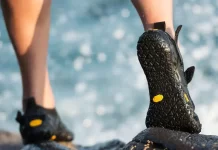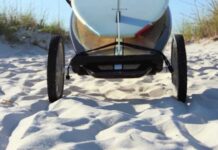We all know the importance of staying safe while enjoying water sports like SUP boarding. But what about the proper fit of a PFD (personal flotation device) during this activity? It turns out that finding the right fit for a PFD can make all the difference in ensuring our safety and comfort while paddleboarding. In this article, we’ll explore the key factors to consider when choosing a PFD for SUP boarding and how to achieve the perfect fit for a worry-free experience on the water. So, let’s dive in and discover the secrets to a properly fitting PFD for SUP boarding!
Choosing the Right PFD
Considerations for SUP Boarding
When it comes to stand-up paddleboarding (SUP), safety should always be a priority. One essential piece of safety equipment that every SUP enthusiast must have is a personal flotation device (PFD). But with so many options available, how do you choose the right one? Here are a few important considerations to keep in mind when selecting a PFD for SUP boarding.
First and foremost, you’ll want to choose a PFD that is specifically designed for paddleboarding. These PFDs are typically low-profile, allowing for greater freedom of movement and minimizing interference with your paddle stroke. Look for features like a short waist, open sides, and a high back, which will provide the best fit and functionality while out on the water.
Types of PFDs for SUP Boarding
There are several types of PFDs that are suitable for SUP boarding, each with its own unique features and benefits. The most common types include inflatable PFDs, foam PFDs, and hybrid PFDs.
Inflatable PFDs are popular among SUP boarders due to their compact size and ease of use. They are designed to be manually or automatically inflated upon immersion in water. These PFDs offer excellent mobility and comfort but require regular maintenance and inspection to ensure proper functionality.
Foam PFDs, on the other hand, are inherently buoyant and do not require any inflation mechanisms. They provide consistent buoyancy and are generally more durable than inflatable PFDs. Foam PFDs are a great choice for those who prefer a hassle-free option that requires minimal maintenance.
Hybrid PFDs combine the advantages of both inflatable and foam PFDs. They feature a foam core for inherent flotation and an inflatable bladder for additional buoyancy when needed. Hybrid PFDs offer versatility and can be adjusted based on the user’s preferences and conditions.
Sizing Guide for PFDs
Measuring Your Chest
Proper fit is crucial when it comes to choosing a PFD for SUP boarding. To ensure a secure and comfortable fit, it’s essential to measure your chest correctly. Using a soft tape measure, wrap it around the widest part of your chest, just under your arms and across your shoulder blades. Take note of the measurement in inches or centimeters, as this will be the basis for selecting the appropriate PFD size.
Adjustable vs. Fixed-Sized PFDs
PFDs come in both adjustable and fixed-sized options, and each has its advantages. Adjustable PFDs typically feature straps, buckles, or a combination of both, allowing for a customizable fit. These are a great option if you plan on layering your PFD over different clothing or if you anticipate weight fluctuations. Fixed-sized PFDs, on the other hand, have a predetermined size and are not adjustable. They often provide a more streamlined fit and are generally more lightweight.
When deciding between adjustable and fixed-sized PFDs, consider factors such as comfort, ease of use, and the level of adjustability you desire. Remember, a properly fitted PFD should feel snug but not constricting, with the buoyancy panels resting at or just above your chest.
Proper Fit and Adjustments
Proper Positioning
Once you’ve chosen the right size and type of PFD for SUP boarding, it’s important to ensure that it is positioned correctly on your body. The PFD should be snugly fitted, with the bottom edge sitting just above your ribcage and the shoulder straps adjusted to prevent the PFD from riding up.
If your PFD has a high back, make sure it aligns with the curve of your lower back. This will provide optimal coverage and support without hindering your movement while paddleboarding. It’s also a good idea to check that the front zipper or closure is positioned centrally and secure to avoid any shifting or discomfort during your paddling adventures.
Checking for Adequate Buoyancy
Buoyancy is a critical factor in any PFD, as it ensures your body remains afloat in the water. When selecting a PFD for SUP boarding, it’s important to check that it provides adequate buoyancy for your weight and body type. PFDs are typically classified by their buoyancy rating, measured in pounds or newtons.
The recommended minimum buoyancy for SUP boarding is 15.5 pounds (70 newtons). However, keep in mind that individual requirements may vary based on factors such as skill level, water conditions, and personal preference. To ensure your PFD offers sufficient buoyancy, consult the manufacturer’s guidelines and choose a PFD that matches your weight and intended usage.
Adjusting the Straps
Properly adjusting the straps on your PFD is crucial to achieving a secure and comfortable fit. Begin by loosening all the straps, and then put the PFD on. Gradually tighten the straps, starting with the waist strap and then the shoulder and side straps, until the PFD feels snug but not restrictive. Ensure that the straps are evenly tightened, and check for any loose ends that may potentially interfere with your paddle stroke or cause discomfort.
It’s important to note that straps should never be over-tightened, as this may restrict blood flow and limit your range of motion. Make sure the straps are well-positioned, and avoid any excessive twisting or tangling that may compromise the fit and effectiveness of the PFD.
Ensuring Comfort and Mobility
Range of Motion
When engaging in any water activity, it’s crucial to have a PFD that doesn’t restrict your range of motion. Stand-up paddleboarding requires a full range of upper body movement, making comfort and mobility key considerations when choosing a PFD.
Look for a PFD that allows for unrestricted shoulder movement and doesn’t impede your ability to paddle freely. PFDs with open sides or mesh panels are excellent options, as they provide ventilation, minimize chafing, and allow for a wide range of motion. Avoid bulky or cumbersome designs that can limit your maneuverability on the water.
Avoiding Chafing
Chafing can quickly turn an enjoyable SUP session into an uncomfortable experience. To prevent chafing, choose a PFD with soft, smooth materials and avoid any rough or scratchy surfaces that could irritate your skin during prolonged use. Consider PFDs with neoprene or padded shoulder straps for added comfort and protection against chafing.
In addition to selecting the right materials, proper fitting and adjustment of your PFD can also help minimize chafing. Ensure that your PFD is snug but not overly tight, and check for any areas where the PFD may rub against your skin. If necessary, use body glide or other anti-chafing products in areas prone to friction.
Choosing Lightweight Materials
When spending hours on the water, the weight of your PFD becomes a significant factor in your overall comfort. Look for PFDs made from lightweight materials that won’t weigh you down or cause unnecessary fatigue. Foam PFDs tend to be lighter than inflatable PFDs, making them a popular choice for many SUP boarders.
Additionally, consider the design and construction of the PFD. Opt for streamlined, low-profile styles that won’t hinder your movements or feel cumbersome. Remember, the more comfortable and unobtrusive your PFD feels, the more enjoyable and fulfilling your SUP boarding experience will be.
Additional Considerations
Visibility and Bright Colors
Stand-up paddleboarding often takes place in busy waterways where other boaters may be present. To enhance your safety and visibility, choose a PFD in a bright color that is easily noticeable. Reflective strips or panels on the PFD can also increase visibility in low light conditions, further reducing the risk of accidents and ensuring that you can be seen by others on the water.
PFDs with Integrated Safety Features
Some PFDs come with integrated safety features that can be particularly beneficial for SUP boarders. Look for PFDs with built-in whistles, which can serve as essential signaling devices in case of an emergency. Additionally, consider PFDs with pockets or attachment points for carrying essentials such as a whistle, knife, or marine radio. These integrated safety features can provide added peace of mind while out on the water.
Storage and Attachment Options
When choosing a PFD for SUP boarding, think about your specific needs and preferences regarding storage and attachment options. If you like to carry a water bottle, snacks, or other essentials, consider PFDs with pockets or attachment points where you can secure these items. Some PFDs even come with hydration bladder compatibility, allowing you to stay hydrated without the need for a separate water bottle.
Additionally, look for PFDs with D-rings or loops that can be used to attach accessories such as a leash or safety tether. These attachment options can be particularly useful if you plan on practicing yoga or fishing while paddleboarding, as they provide secure points for attaching equipment or tools.
Choosing the right PFD for SUP boarding is crucial for your safety and enjoyment on the water. Consider factors such as the type of PFD, sizing, proper fit and adjustments, comfort and mobility, visibility, integrated safety features, and storage options. By carefully evaluating these considerations and selecting a PFD that meets your specific needs, you’ll be well-equipped to embark on your paddleboarding adventures with confidence and peace of mind. Safe paddling!





































